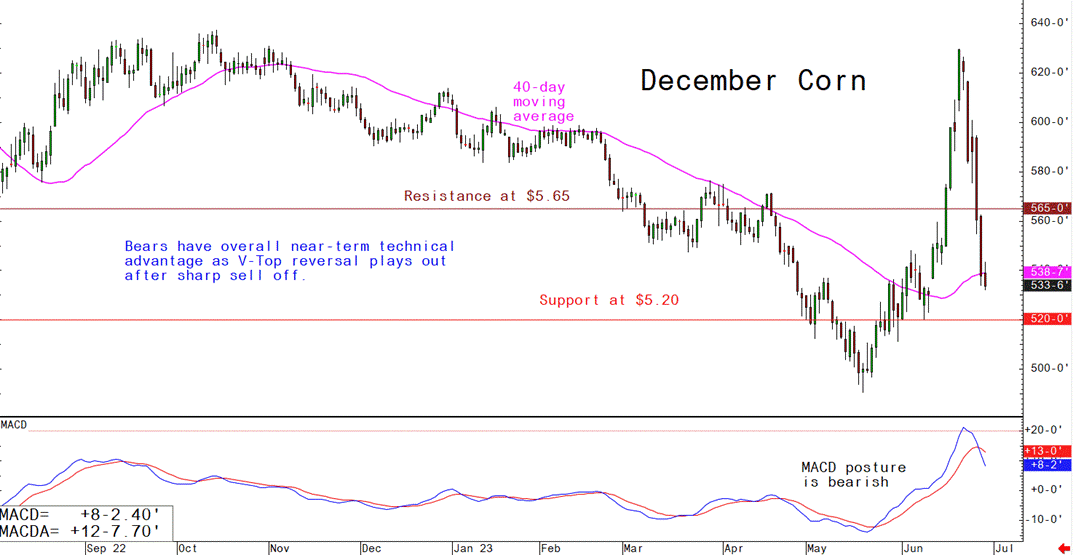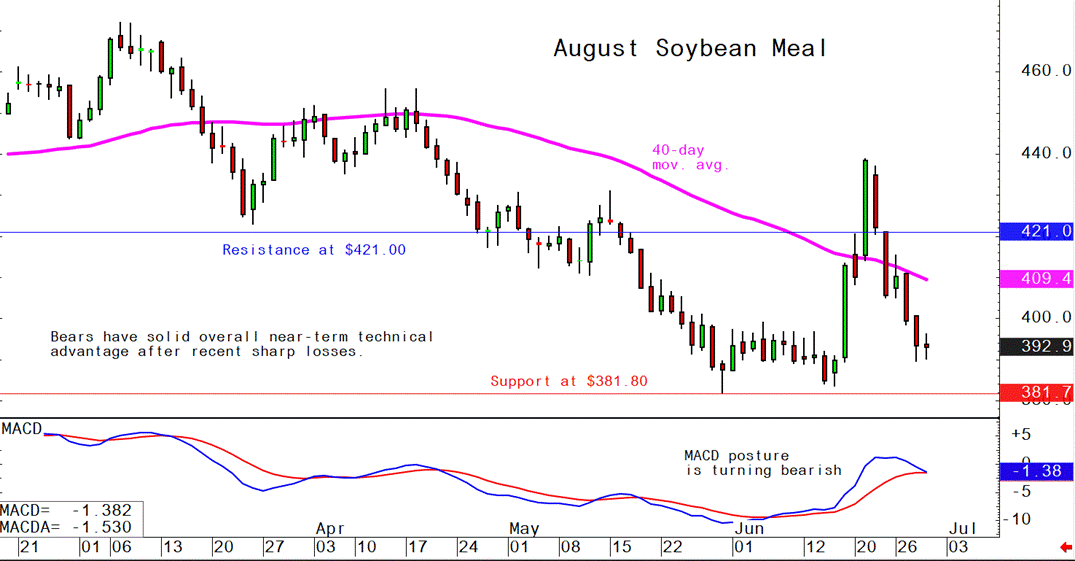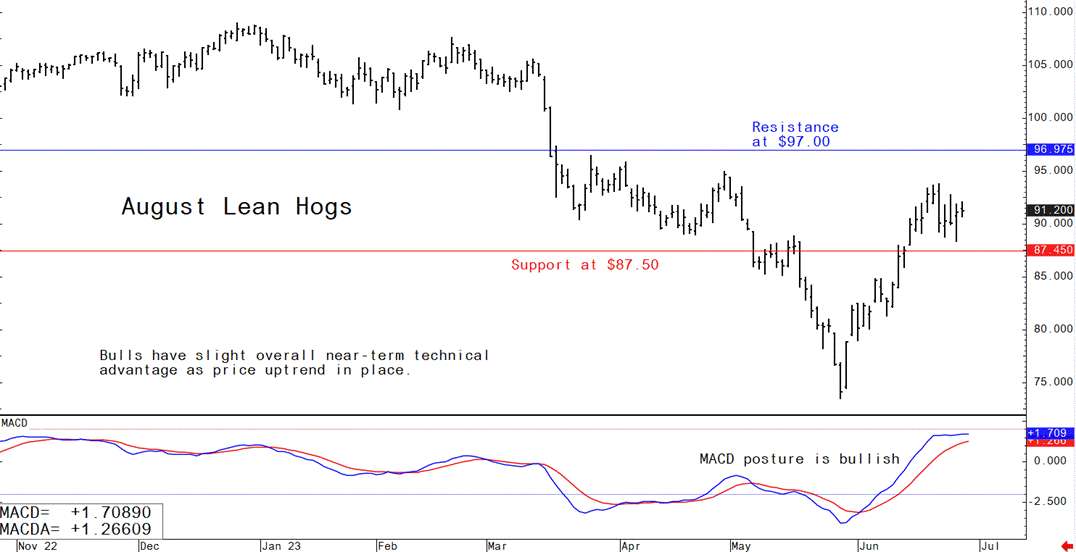



Pig outlook: Lean hog futures bulls keeping price uptrend alive
Livestock analyst Jim Wyckoff shares global swine newsThe August lean hog futures market sees a four-week-old price uptrend still alive on the daily bar chart. The latest CME lean hog index was up another 44 cents to $92.96 (as of June 27). Since bottoming in the third week of April, the cash index has rallied $21.78. While daily price gains haven’t been strong, the seasonal climb has been steady. Demand has picked up for pork, as evidenced by the persistent wholesale loads near 300. This week showed the first cutout value over $100 since last October. Meantime, hog weights continue below both a year-ago and the five-year averages.
Weekly USDA export sales for US pork
Pork: Net sales of 26,700 MT for 2023 were down 7 percent from the previous week, but up 3 percent from the prior 4-week average. Increases were primarily for Mexico (15,100 MT, including decreases of 200 MT), South Korea (4,100 MT, including decreases of 300 MT), Japan (2,600 MT, including decreases of 300 MT), Colombia (1,300 MT, including decreases of 100 MT), and Canada (1,300 MT, including decreases of 700 MT). Exports of 29,300 MT were down 3 percent from the previous week and 6 percent from the prior 4-week average. The destinations were primarily to Mexico (9,300 MT), China (3,900 MT), Japan (3,700 MT), South Korea (2,800 MT), and Australia (1,900 MT)
Croatia reports African swine fever in domestic pig
Croatia has detected an outbreak of African swine fever in two pig farms in the eastern parts of the country, Reuters reported, citing the country's agriculture ministry late on Monday. The Croatian veterinary institute has ordered preliminary measures to subdue the outbreak, including ban on pigs' movement and culling of the animals. It reported another two locations suspicious for the disease in the nearby area.
USDA Hog & Pigs Report out Thursday afternoon
Analysts expect USDA’s Hogs & Pigs Report this afternoon to show the U.S. hog herd as of June 1 was fractionally smaller than year-ago. In fact, all of the categories except spring pigs per litter are expected to be down slightly from last year. Key in the report will be any revisions to past data and the weight breakdown of market hogs for an indication of hog slaughter during the second half of the year.
USDA Secretary Vilsack to announce more funding for meat processing
USDA Secretary Tom Vilsack will announce $115 million will be distributed across 17 states in the form of 15 awards to augment meat and poultry processing capacity. This announcement will be made in Des Moines, Iowa. The National Institute of Food and Agriculture managed by USDA will also grant seven awards totaling $4.5 million to community and technical colleges for the training of meat processing workers. The industry has been facing labor supply issues. The funding will be allocated as follows: the Meat and Poultry Processing Expansion Program will distribute five awards totaling $38 million to support smaller, independent processing firms. The Meat and Poultry Intermediary Lending Program will dispense ten awards cumulating $77 million. The funding for the educational grants will be channeled through the Meat and Poultry Processing — Agricultural Workforce Training program.
FAO says total global meat production forecast to increase marginally in 2023
World total meat production in 2023 is forecast to increase marginally to 364 million tonnes (carcass weight equivalent), according to an FAO report. Growth will be driven in part by an anticipated increase in global poultry meat production, which is forecast to expand the most by volume, facilitated by increased demand from the food services sector and its general appeal as a relatively affordable meat type, despite widespread outbreaks of the highly pathogenic avian influenza virus and elevated feed prices.
By contrast, global pig meat production is expected to drop slightly, principally underpinned by a steep drop in output in Europe due to the continued impact of the African swine fever virus, weaker producer margins and somewhat lower domestic demand. Global bovine meat production is also forecast to fall marginally on lower cattle inventories, high feed costs, forage shortages and lower carcass weight in several leading producing regions, despite some increases elsewhere.
California releases court order that modifies the California Proposition 12 implementation
NPPC last Friday said that “Contrary to some reporting, this is not a delay of all of Proposition 12, rather it is an adjustment related to the sale of whole pork meat. This is an extension of time for the sale of non-compliant whole pork meat, provided that the meat is in the supply chain by July 1. If it is in the supply chain by July 1, that product can be sold in California until December 31. Anything harvested after July 1, to be sold in California, will still have to be Proposition 12 compliant.” As to the significance of the order, NPPC said “California recognized that if something was not done on the implementation of Proposition 12, consumers in the state could potentially face increased food prices and a significant decrease in amount of pork supplied to the state.”
GAO: OSHA should strengthen rules to protect meat and poultry workers from infectious disease
US Meatpacking plants experienced high rates of Covid-19 infections due to workers standing close together, cold temperatures, and the need to shout over machinery. USDA and the Department of Labor (DOL) did not collaborate effectively to protect worker health, according to a Government Accountability Office (GAO) report. Over 86,000 meatpacking workers contracted coronavirus and 423 died before October 2021, with infection risks in some plants much higher than the general population.
The GAO recommends the Occupational Safety and Health Administration (OSHA) investigate infectious disease dangers in meat and poultry processing and determine how to better protect workers. The report states that OSHA and the Food Safety and Inspection Service (FSIS) have not found a way to reconcile their differing missions. OSHA has previously been criticized for not protecting meat industry workers.
The GAO report suggests both agencies meet regularly to resolve collaboration challenges. OSHA was also found to have inadequately investigated many meatpacking worker deaths during the pandemic, often using rapid response investigations that did not involve visiting plants.
US senators introduce the Livestock Disaster Relief Act
The bipartisan bill, introduced by Sens. John Hoeven (R-N.D.) and Jon Tester (D-Mont.) is aimed at improving the Livestock Forage Program (LFP) and Emergency Assistance for Livestock Program (ELAP) — see related item below for background information on these programs.
The proposed legislation seeks to better support ranchers affected by natural disasters. It includes the following improvements:
- Better alignment of coverage between LFP and ELAP,
- Increased producer assistance under LFP for more accurate feed cost compensation,
- Specified transportation costs for feed, water, and livestock as covered losses under ELAP,
- Makes these program enhancements permanent.
The senators aim to advance the legislation as part of the upcoming farm bill.
US farmers are facing a crisis as the pork industry undergoes a difficult cycle
The world's largest hog producer, Smithfield Foods' CEO Shane Smith, predicts that some U.S. hog producers may start selling their corn instead of using it as animal feed. This comes because of growers losing up to $80 per head due to dwindling demand from China and rising feed costs. The situation has been exacerbated by the worst corn crop conditions since 1992, causing prices to soar and putting farmers in a tough spot. Additionally, stricter animal welfare laws in California have further increased production costs. The American meat market is facing a glut, and Smith believes it might take until the end of 2024 to normalize.
The next week’s likely high-low price trading ranges:
August lean hog futures--$88.00 to $97.50 and with a sideways-higher bias
August soybean meal futures--$381.80 to $420.00, and with a sideways bias
December corn futures--$5.00 to $5.65 and a sideways-lower bias
Latest analytical daily charts lean hog, soybean meal and corn futures












